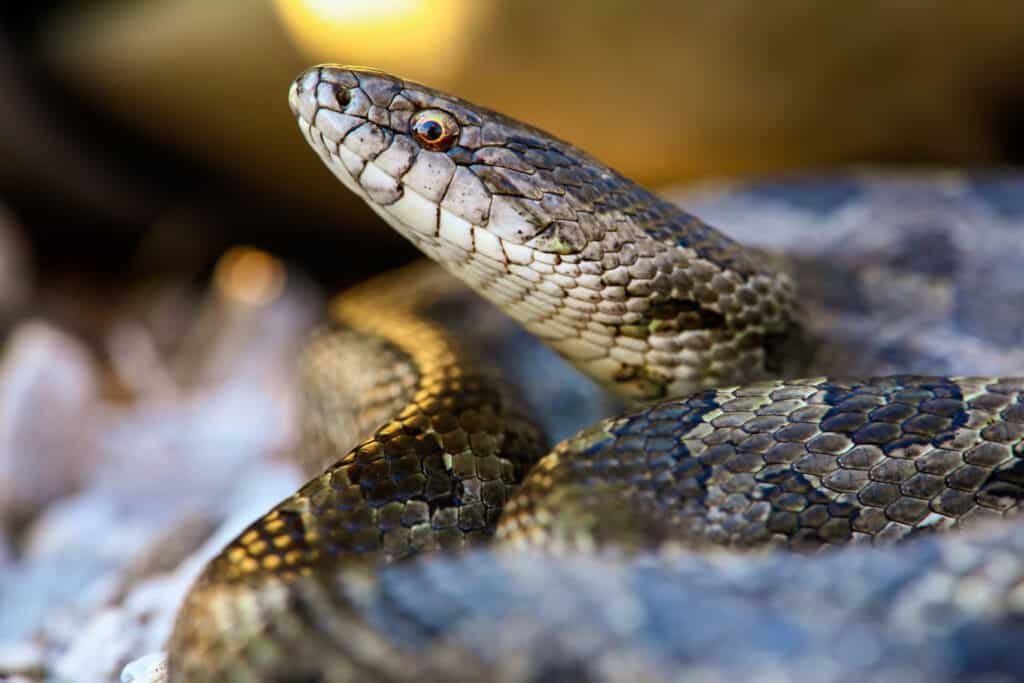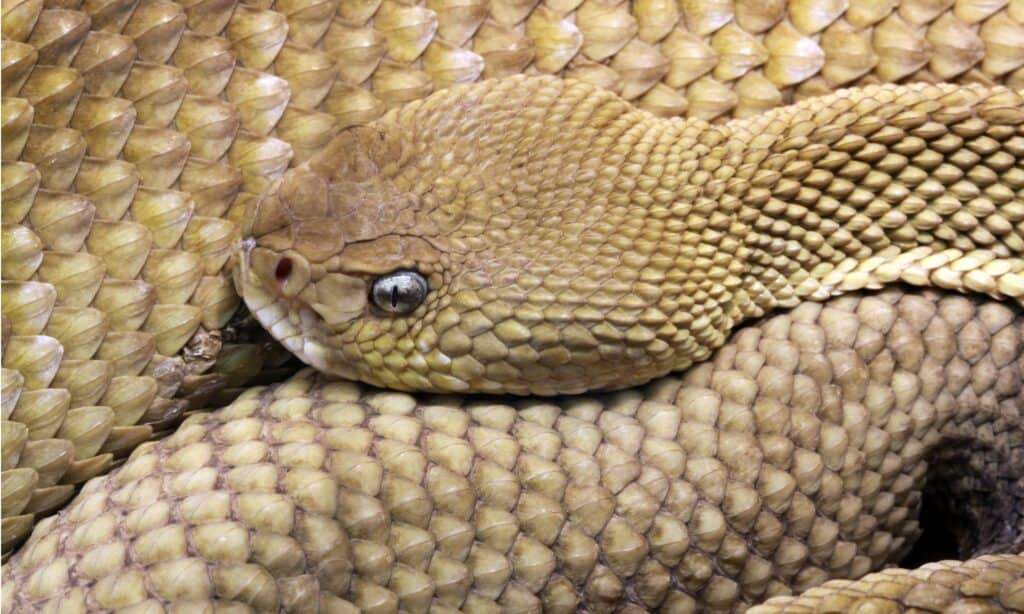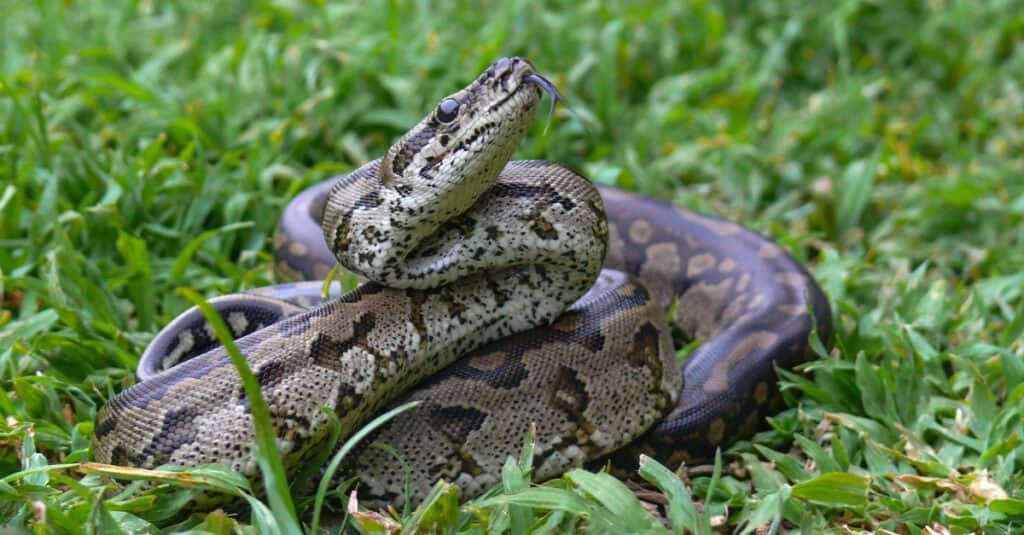Winter comes with that hard-to-deny urge to stay inside, wrapped in a blanket with a steaming cup of hot chocolate. If you feel this way during the colder months, you might be intrigued to find that snakes aren’t all that different. While a cup of steaming beverage might not appeal to snakes, they have a similar desire for warmth.
Since snakes are cold-blooded while humans are warm-blooded, it’s quite interesting to study how snakes spend their winters. If you’ve ever wondered what exactly snakes get up to when the ground is snow-filled, and the air is chilly, this article explains it all. Discover where snakes go in the winter here!
How Does Winter Affect Snakes?

Snakes are cold-blooded and rely on their environment’s temperature.
©bradenjalexander/Shutterstock.com
Like all reptiles, snakes are cold-blooded, which means they rely on their environment’s temperature. Cold-blooded creatures are particularly susceptible to extreme temperatures. When snakes are exposed to temperatures below 60 degrees Fahrenheit, they become sluggish and when they are exposed to temperatures above 95 degrees Fahrenheit, they become overheated.
This does not mean that extreme temperatures instantly kill these animals. A study on garter snakes showed that snakes can recover fully after up to 3 hours of exposure to freezing temperatures of −2.5 °C. After 3 hours, their chances of survival rapidly decrease, and by 48 hours or less, they die.
In America, it gets as cold as -70 degrees Fahrenheit in some winter months. Snakes would not be able to survive such harsh temperatures for prolonged periods, so they opt for a course of action to help them survive the cold winter months. In addition to the cold weather, food is harder to find during winter, and as you know, snakes cannot keep a supply of live rodents to eat during those months.
Snake Brumation
Instead of hibernation, snakes brumate. Brumation is the cold-blooded animals’ version of hibernation. To put it plainly: cold-blooded animals brumate while warm-blooded animals hibernate. Brumation occurs when a cold-blooded animal slows down its metabolism to conserve energy during winter. They do this by slowing down their heart and respiratory rates.
Before winter, snakes save up fat and glycogen and during the winter periods, they rely mostly on their glycogen levels to keep them alive. Some other animals that brumate are frogs, turtles, and lizards. Research has shown that animals that brumate may lose some memories made before brumation.
Do All Snakes Brumate?
Not all snakes brumate. Brumation is only possible and necessary in cold areas. In tropical areas, snakes do not need to brumate since the weather doesn’t get deathly cold. Pet snakes will not brumate as humans regulate temperatures in homes. However, some pets will fast during this period even if they do not need to due to their instincts. This is called a pseudo-brumation state. Experienced snake owners often put such pets into brumation.
Also, since brumation is necessary for reproduction in many snake species, some pet owners adjust with temperatures to mimic winter and force the snake into brumation. This is dangerous and can result in the snake’s death if any mistake is made.
Hibernation Vs Brumation: What’s the Difference?
The major difference between hibernation and brumation is that hibernation is only carried out by warm-blooded animals, while brumation is carried out by cold-blooded animals. Hibernating animals survive on their body fat accumulated in warmer months. Cold-blooded animals survive off accumulated glycogen and wait for warmer days to stretch in the sun, search for water, hunt and forage. Brumating animals also use a lot less oxygen than hibernating animals. Some animals that hibernate are bats, chipmunks, and hedgehogs.
Where Do Snakes Go In The Winter?

Snakes, in the winter, go to warm places, like dens, to brumate.
©iStock.com/Ben185
In the winter, snakes pick warm places where they can comfortably brumate. They can pick dens, caves, tree stumps, and deep caverns. Animals that brumate ensure their chosen locations will shield them from harsh rain, wind, or snow. They may also pick large rocks or logs to hide beneath. Snakes have also been found brumating in basements, garages, wood piles, car engines, sheds, crawlspaces, and barns.
Some snakes may brumate with other snakes of the same species in a hibernaculum of their choosing, and some snakes even brumate with snakes of other species. During such group brumation, snakes cuddle each other to stay warm.
Timber rattlesnakes return to the same spot where they were born to hibernate each year. They often share their hibernacula or dens with racer snakes. However, these sneaky snakes may prey on baby rattlesnakes while their parents aren’t aware.
How Long Does Snake Brumation Last?
The duration of brumation depends on several things, such as the species of the snake, temperatures, and location. Snakes can hibernate for a few weeks up to 4 months.
3 Snakes That Do Not Brumate

Central African rock pythons do not brumate in their native climates.
©Chris Graf/Shutterstock.com
Ball pythons, Gaboon vipers, and Central African rock pythons are three snakes that do not brumate. These snakes are native to tropical areas that don’t get cold enough to trigger a brumation cycle.
What Happens After Snake Brumation?
After brumation, snakes wake up. First, they go into the sun to warm their bodies for long periods. Then they hunt for food and water, and female snakes that mated and stored sperm just before brumation will start the conception process. Others begin looking for a mate.
What To Do If You Spot A Brumating Snake
Since brumation doesn’t require as much sleep as hibernation, it is possible to wake a brumating snake. Doing this can endanger the snake’s life as it will have to spend energy getting away from you. If you spot a brumating snake, leave it alone. Do not attempt to take it in and warm it up, as you could be endangering its life.
Can Brumating Snakes Bite?
Yes, brumating snakes can indeed bite. Although they are conserving energy by being asleep, they can wake if they are disturbed. Brumating snakes are less likely to attack, but they can and will if they feel threatened. Remember that most snake bites are the result of meddlesome humans. However, do not attempt first aid if a snake has bitten you. Instead, contact your local poison control center. Remember the famous saying: the best first aid treatment for a snake bite is a pair of keys.
The photo featured at the top of this post is © SusImage/Shutterstock.com
Discover the "Monster" Snake 5X Bigger than an Anaconda
Every day A-Z Animals sends out some of the most incredible facts in the world from our free newsletter. Want to discover the 10 most beautiful snakes in the world, a "snake island" where you're never more than 3 feet from danger, or a "monster" snake 5X larger than an anaconda? Then sign up right now and you'll start receiving our daily newsletter absolutely free.
Thank you for reading! Have some feedback for us? Contact the AZ Animals editorial team.






